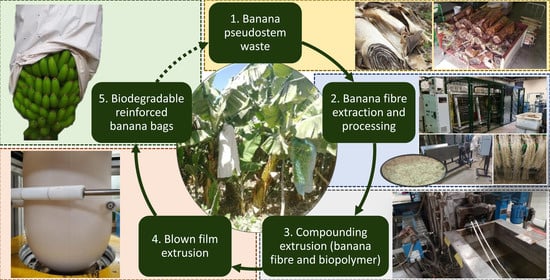Biodegradable Polymer Compounds Reinforced with Banana Fiber for the Production of Protective Bags for Banana Fruits in the Context of Circular Economy
Abstract
1. Introduction
2. Materials and Methods
2.1. Biomaterials and Additives
2.2. Banana Fiber
- Preliminary tests: untreated banana fiber (3 and 5 mm length), and also 2 mm combed banana fiber (obtained during the extraction of the 2nd film generation)
- 1st film generation: treated banana fiber (1N NaOH) (2 mm length)
- 2nd film generation: treated and sieved banana fiber (1N NaOH) (2 mm length) (micronized compounding)
- 3rd film generation: untreated, combed and sieved banana fiber (2 mm length) (micronized compounding)
2.3. Compounding Extrusion
2.4. Mechanical Characterization
2.5. Film Blowing Extrusion
2.6. Validation in Field
2.7. Composting and Biodegradability Tests
2.7.1. Initial Characterization
2.7.2. Composting Test
2.7.3. Disintegration Test and Final Compost Quality
- Case 1: Acceptance if the concentration values of both the substrate alone (A), and the substrate and test material (B), are equal or lower than L (A and B ≤ L).
- Case 2: When the previous condition is not fulfilled, acceptance if the difference between the concentrations of the substrate and test material (B), and the substrate alone (A), are equal or lower than L (B − A ≤ L). This additional criterion allows evaluating the real effect of the test material regardless of the quality of the initial substrate.
2.7.4. Ecotoxicity
- Lighting for 16 h a day at minimum of 3000 lx (with light at a wavelength suitable for photosynthesis), at 25 °C and 70% relative humidity.
- Dark phase of 8 h a day, at 20 °C and 80% of relative humidity.
- Incubation period: 14–21 days from the time that 50% of the control plants are germinated.
- At least 70% of the seeds must germinate.
- At least 90% of these must survive throughout the test.
- Grown plants must show no phytotoxic effects (necrosis, chlorosis, rot, etc.).
3. Results and Discussion
3.1. Preliminary Test
3.1.1. Compounding Extrusion Preliminary Results
3.1.2. Preliminary Mechanical Test
3.1.3. Film Blowing Preliminary Test
3.2. Development of Reinforced Biopolymers
3.2.1. Compounding Extrusion
3.2.2. Mechanical Test
3.2.3. Film Blowing
3.2.4. Validation in Field
3.3. Biodegradability Test
3.3.1. Initial Characterization
3.3.2. Composting Test
3.3.3. Disintegration Test and Final Compost Quality
3.3.4. Ecotoxicity Test
4. Conclusions
Author Contributions
Funding
Data Availability Statement
Conflicts of Interest
References
- European Commission. Circular Economy Action Plan. In For a Cleaner and More Competitive Europe; European Commission: Brussels, Belgium, 2020. [Google Scholar]
- Bourguignon, D. Closing the Loop. New Circular Economy Package; European Union: Brussels, Belgium, 2016. [Google Scholar]
- Borrello, M.; Lombardi, A.; Pascucci, S.; Cembalo, L. The Seven Challenges for Transitioning into a Bio-based Circular Economy in the Agri-food Sector. Recent Patents Food Nutr. Agric. 2016, 8, 39–47. [Google Scholar] [CrossRef] [PubMed]
- Suffo, M.; De La Mata, M.; Molina, S. A sugar-beet waste based thermoplastic agro-composite as substitute for raw materials. J. Clean. Prod. 2020, 257, 120382. [Google Scholar] [CrossRef]
- Lucarini, M.; Durazzo, A.; Romani, A.; Campo, M.; Boccia, G.L.; Cecchini, F. Bio-Based Compounds from Grape Seeds: A Biorefinery Approach. Molecules 2018, 23, 1888. [Google Scholar] [CrossRef] [PubMed]
- Chiellini, E.; Cinelli, P.; Imam, S.H.; Mao, L. Composite Films Based on Biorelated Agro-Industrial Waste and Poly(vinyl alcohol). Preparation and Mechanical Properties Characterization. Biomacromolecules 2001, 2, 1029–1037. [Google Scholar] [CrossRef] [PubMed]
- Nair, K.M.; Thomas, S.; Groeninckx, G. Thermal and dynamic mechanical analysis of polystyrene composites reinforced with short sisal fibres. Compos. Sci. Technol. 2001, 61, 2519–2529. [Google Scholar] [CrossRef]
- Bakare, I.; Okieimen, F.; Pavithran, C.; Khalil, H.A.; Brahmakumar, M. Mechanical and thermal properties of sisal fiber-reinforced rubber seed oil-based polyurethane composites. Mater. Des. 2010, 31, 4274–4280. [Google Scholar] [CrossRef]
- Zhu, Z.; Wu, H.; Ye, C.; Fu, W. Enhancement on Mechanical and Thermal Properties of PLA Biocomposites Due to the Addition of Hybrid Sisal Fibers. J. Nat. Fibers 2017, 14, 875–886. [Google Scholar] [CrossRef]
- Nayak, S.K.; Mohanty, S. Sisal Glass Fiber Reinforced PP Hybrid Composites: Effect of MAPP on the Dynamic Mechanical and Thermal Properties. J. Reinf. Plast. Compos. 2009, 29, 1551–1568. [Google Scholar] [CrossRef]
- Idicula, M.; Neelakantan, N.R.; Oommen, Z.; Joseph, K.; Thomas, S. A study of the mechanical properties of randomly oriented short banana and sisal hybrid fiber reinforced polyester composites. J. Appl. Polym. Sci. 2005, 96, 1699–1709. [Google Scholar] [CrossRef]
- Głowińska, E.; Datta, J.; Parcheta, P. Effect of sisal fiber filler on thermal properties of bio-based polyurethane composites. J. Therm. Anal. Calorim. 2017, 130, 113–122. [Google Scholar] [CrossRef]
- Ramnath, B.V.; Manickavasagam, V.; Elanchezhian, C.; Krishna, C.V.; Karthik, S.; Saravanan, K. Determination of mechanical properties of intra-layer abaca–jute–glass fiber reinforced composite. Mater. Des. 2014, 60, 643–652. [Google Scholar] [CrossRef]
- Ramnath, B.V.; Kokan, S.J.; Raja, R.N.; Sathyanarayanan, R.; Elanchezhian, C.; Prasad, A.R.; Manickavasagam, V. Evaluation of mechanical properties of abaca–jute–glass fibre reinforced epoxy composite. Mater. Des. 2013, 51, 357–366. [Google Scholar] [CrossRef]
- Ramana, M.V.; Ramprasad, S. Experimental Investigation on Jute/Carbon Fibre Reinforced Epoxy Based Hybrid Composites. Mater. Today Proc. 2017, 4, 8654–8664. [Google Scholar] [CrossRef]
- Kureemun, U.; Ravandi, M.; Tran, L.; Teo, W.; Tay, T.; Lee, H. Effects of hybridization and hybrid fibre dispersion on the mechanical properties of woven flax-carbon epoxy at low carbon fibre volume fractions. Compos. Part B Eng. 2018, 134, 28–38. [Google Scholar] [CrossRef]
- Akil, H.M.; Santulli, C.; Sarasini, F.; Tirillò, J.; Valente, T. Environmental effects on the mechanical behaviour of pultruded jute/glass fibre-reinforced polyester hybrid composites. Compos. Sci. Technol. 2014, 94, 62–70. [Google Scholar] [CrossRef]
- Jeencham, R.; Suppakarn, N.; Jarukumjorn, K. Effect of flame retardants on flame retardant, mechanical, and thermal properties of sisal fiber/polypropylene composites. Compos. Part B Eng. 2014, 56, 249–253. [Google Scholar] [CrossRef]
- Dunne, R.K.; Desai, D.; Sadiku, R. Material characterization of blended sisal-kenaf composites with an ABS matrix. Appl. Acoust. 2017, 125, 184–193. [Google Scholar] [CrossRef]
- Xia, C.; Shi, S.Q.; Wu, Y.; Cai, L. High pressure-assisted magnesium carbonate impregnated natural fiber-reinforced composites. Ind. Crop. Prod. 2016, 86, 16–22. [Google Scholar] [CrossRef]
- Xia, C.; Wang, K.; Dong, Y.; Zhang, S.; Shi, S.Q.; Cai, L.; Ren, H.; Zhang, H.; Li, J. Dual-functional natural-fiber reinforced composites by incorporating magnetite. Compos. Part B Eng. 2016, 93, 221–228. [Google Scholar] [CrossRef]
- Kusić, D.; Božič, U.; Monzón, M.D.; Paz, R.; Bordón, P. Thermal and Mechanical Characterization of Banana Fiber Reinforced Composites for Its Application in Injection Molding. Materials 2020, 13, 3581. [Google Scholar] [CrossRef]
- Amir, N.; Abidin, K.A.Z.; Shiri, F.B.M. Effects of Fibre Configuration on Mechanical Properties of Banana Fi-bre/PP/MAPP Natural Fibre Reinforced Polymer Composite. Procedia Eng. 2017, 184, 573–580. [Google Scholar] [CrossRef]
- Arthanarieswaran, V.; Kumaravel, A.; Kathirselvam, M. Evaluation of mechanical properties of banana and sisal fiber reinforced epoxy composites: Influence of glass fiber hybridization. Mater. Des. 2014, 64, 194–202. [Google Scholar] [CrossRef]
- European Bioplastics. Global Production Capacities of Bioplastics: Bioplastic Marked Data 2016; European Bioplastics: Berlin, Germany, 2016. [Google Scholar]
- Dreizen, C. 2020 Bioplastics Market Forecast; Markets and Markets Research Private Ltd.: Northbrook, IL, USA, 2017. [Google Scholar]
- European Commission. DG ENV Plastic Waste in the Environment—Final Report; European Commission: Brussels, Belgium, 2011. [Google Scholar]
- European Commision. Questions and Answers on the Proposal to Reduce the Consumption of Plastic Bags; European Commission: Brussels, Belgium, 2013. [Google Scholar]
- Wang, X.; Tang, Y.; Zhu, X.; Zhou, Y.; Hong, X. Preparation and characterization of polylactic acid/polyaniline/nanocrystalline cellulose nanocomposite films. Int. J. Biol. Macromol. 2020, 146, 1069–1075. [Google Scholar] [CrossRef] [PubMed]
- Perumal, A.B.; Sellamuthu, P.S.; Nambiar, R.B.; Sadiku, E.R. Development of polyvinyl alcohol/chitosan bio-nanocomposite films reinforced with cellulose nanocrystals isolated from rice straw. Appl. Surf. Sci. 2018, 449, 591–602. [Google Scholar] [CrossRef]
- Yang, W.; Weng, Y.-X.; Puglia, D.; Qi, G.; Dong, W.; Kenny, J.M.; Ma, P. Poly(lactic acid)/lignin films with enhanced toughness and anti-oxidation performance for active food packaging. Int. J. Biol. Macromol. 2020, 144, 102–110. [Google Scholar] [CrossRef]
- Varghese, S.A.; Pulikkalparambil, H.; Rangappa, S.M.; Siengchin, S.; Parameswaranpillai, J. Novel biodegradable polymer films based on poly(3-hydroxybutyrate-co-3-hydroxyvalerate) and Ceiba pentandra natural fibers for packaging applications. Food Packag. Shelf Life 2020, 25, 100538. [Google Scholar] [CrossRef]
- Berthet, M.-A.; Angelliercoussy, H.; Chea, V.; Guillard, V.; Gastaldi, E.; Gontard, N. Sustainable food packaging: Valorising wheat straw fibres for tuning PHBV-based composites properties. Compos. Part A Appl. Sci. Manuf. 2015, 72, 139–147. [Google Scholar] [CrossRef]
- Cunha, M.; Berthet, M.-A.; Pereira, R.; Covas, J.A.; Vicente, A.A.; Hilliou, L. Development of polyhydroxyalkanoate/beer spent grain fibers composites for film blowing applications. Polym. Compos. 2015, 36, 1859–1865. [Google Scholar] [CrossRef]
- Kharrat, F.; Khlif, M.; Hilliou, L.; Haboussi, M.; Covas, J.; Nouri, H.; Bradai, C. Minimally processed date palm (Phoenix dactylifera L.) leaves as natural fillers and processing aids in poly(lactic acid) composites designed for the extrusion film blowing of thin packages. Ind. Crop. Prod. 2020, 154, 112637. [Google Scholar] [CrossRef]
- Srivastava, K.; Singh, M.K.; Mishra, P.K.; Srivastava, P. Pretreatment of banana pseudostem fibre for green composite packaging film preparation with polyvinyl alcohol. J. Polym. Res. 2019, 26, 95. [Google Scholar] [CrossRef]
- ASPROCAN. Dosier_Estadisticas_Asprocan_2019; ASPROCAN: Santa Cruz de Tenerife, Spain, 2019. [Google Scholar]
- DuPontTM. Polymers, Light and the Science of TiO2; DuPontTM: Wilmington, DE, USA, 2007. [Google Scholar]
- LIFE Multibiosol. Available online: https://multibiosol.eu/ (accessed on 8 January 2021).
- Paz, R.; Monzón, M.; Vega, G.; Díaz, N.; Pestana, D. Use of Banana Crop Wastes to Develop Products in the Aquaculture and Plastic Sectors. In Agricultural, Forestry and Bioindustry Biotechnology and Biodiscovery; Springer Nature: Berlin/Heidelberg, Germany, 2020; pp. 259–270. [Google Scholar]
- Vega Rodríguez, G.; Monzón, M.; Díaz Padilla, N.; Paz Hernández, R. Pilot Plant for the New Use of a Waste of Banana Crop to Develop Products of Plastic Composite and Aquaculture. In Proceedings of the Materials & Nanomaterials. An International Conference, Paris, France, 17–19 July 2019; Sciknowledge: Badajoz, Spain, 2019. [Google Scholar]
- Ortega, Z.; Monzón, M.D.; Benítez, A.N.; Kearns, M.; McCourt, M.; Hornsby, P.R. Banana and Abaca Fiber-Reinforced Plastic Composites Obtained by Rotational Molding Process. Mater. Manuf. Process. 2013, 28, 130614085148001. [Google Scholar] [CrossRef]
- Benítez, A.; Monzón, M.; Angulo, I.; Ortega, Z.; Hernández, P.; Marrero, M. Treatment of banana fiber for use in the reinforcement of polymeric matrices. Measurement 2013, 46, 1065–1073. [Google Scholar] [CrossRef]
- Díaz, N.; Ortega, R.; Monzón, M.D.; Pestana, D.; Paz, R. Pilot Plant for Alkali Treatment of Chopped Banana Fibre. In Proceedings of the 4th International Conference on Green Chemistry and Sustainable Engineering (GreenChem-18), Madrid, Spain, 23–25 July 2018; Royal Society of Chemistry: Cambridge, UK, 2018. [Google Scholar]
- Overview of Materials for Low Density Polyethylene (LDPE), Blow Molding Grade. Available online: http://www.matweb.com/search/datasheet_print.aspx?matguid=b34a78d271064c4f85f28a9ffaf94045 (accessed on 8 January 2021).
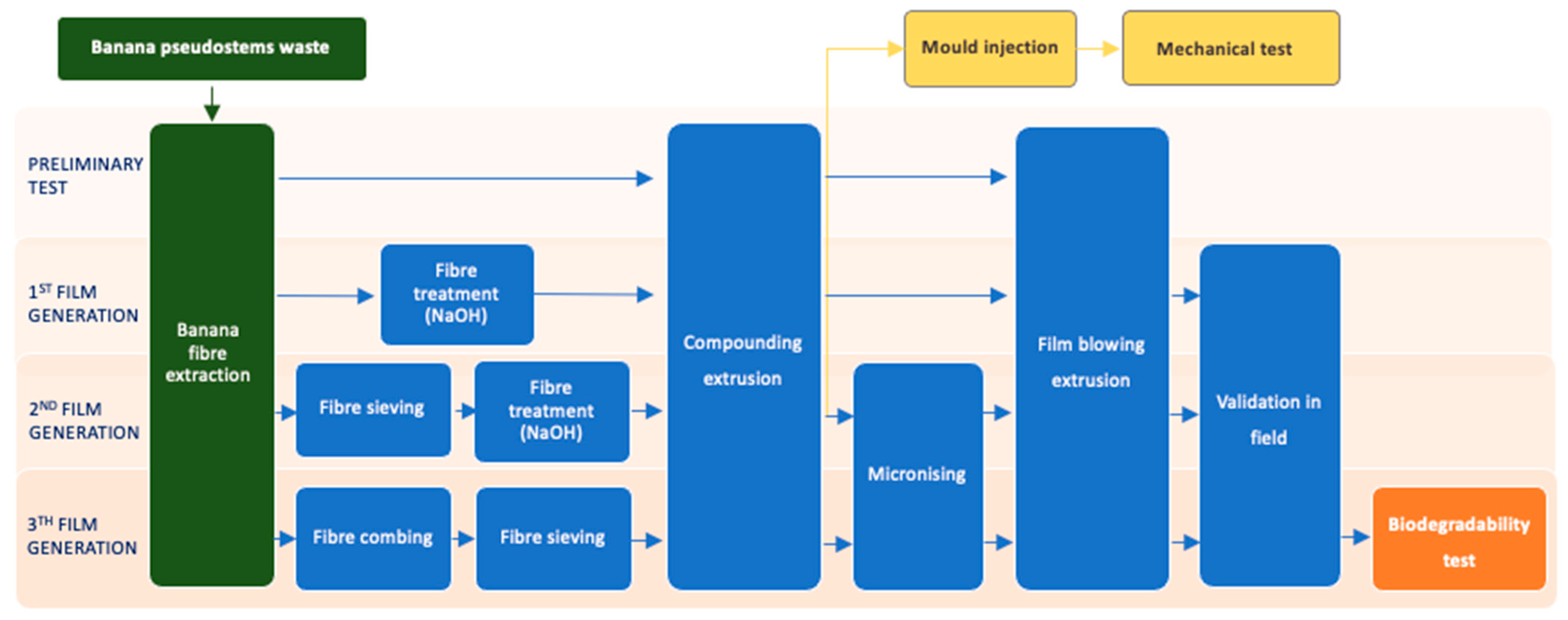
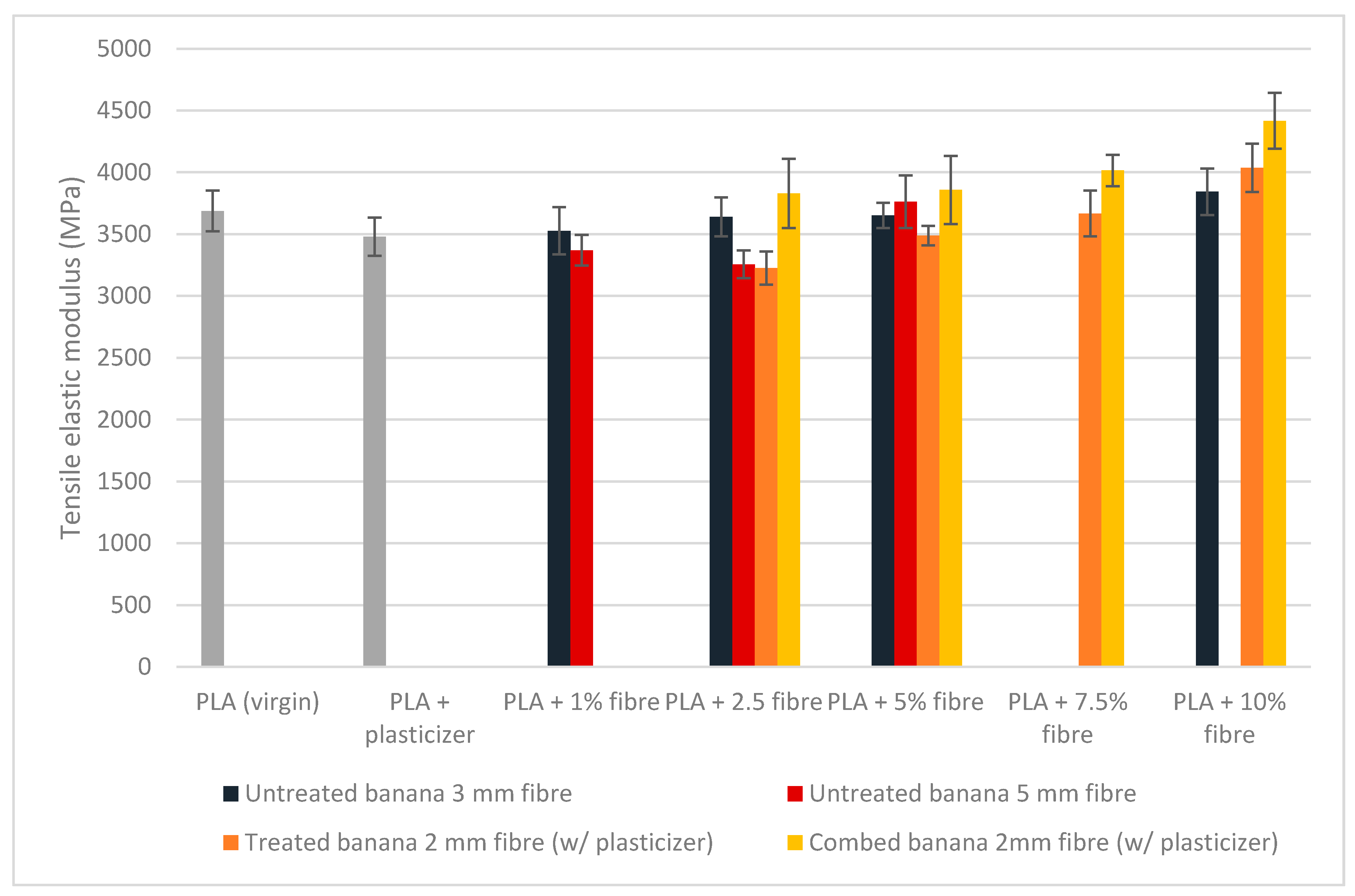

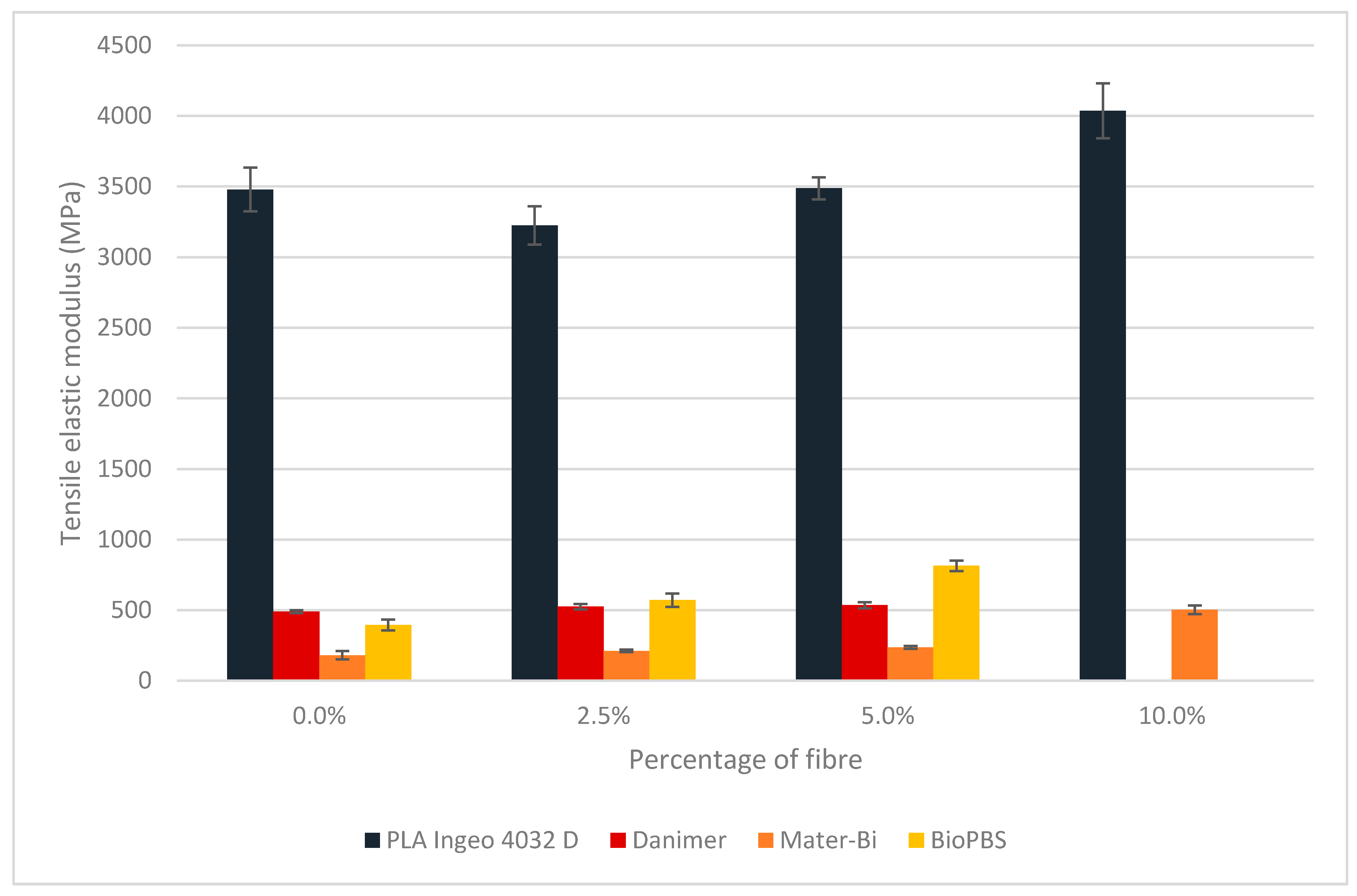
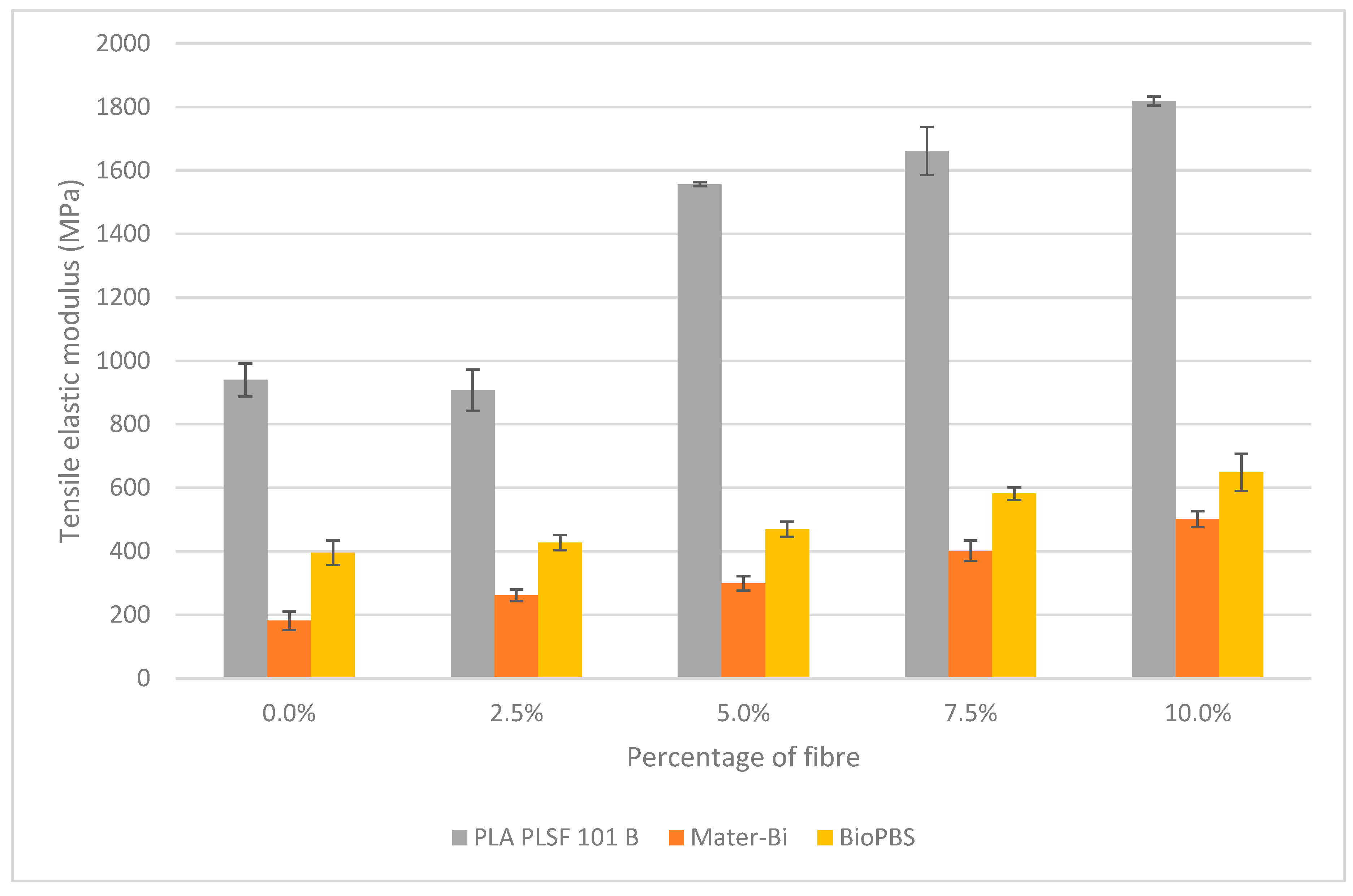
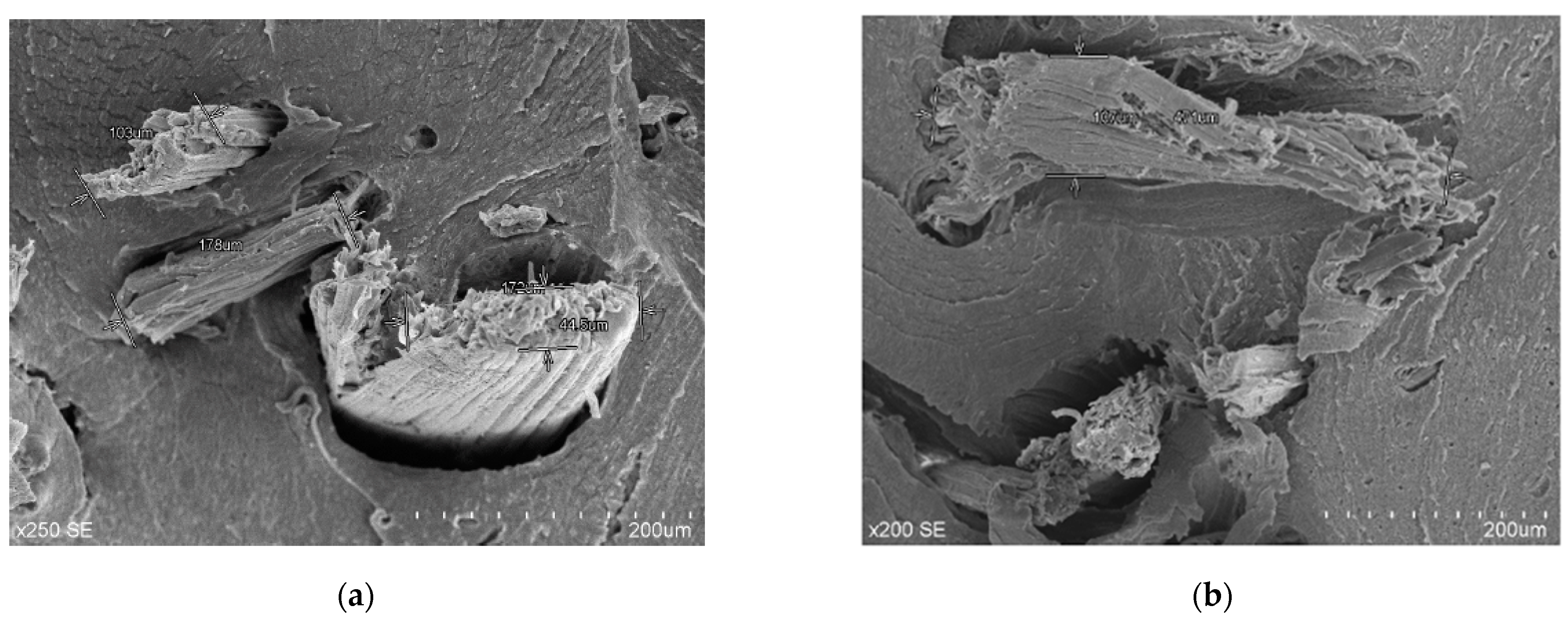
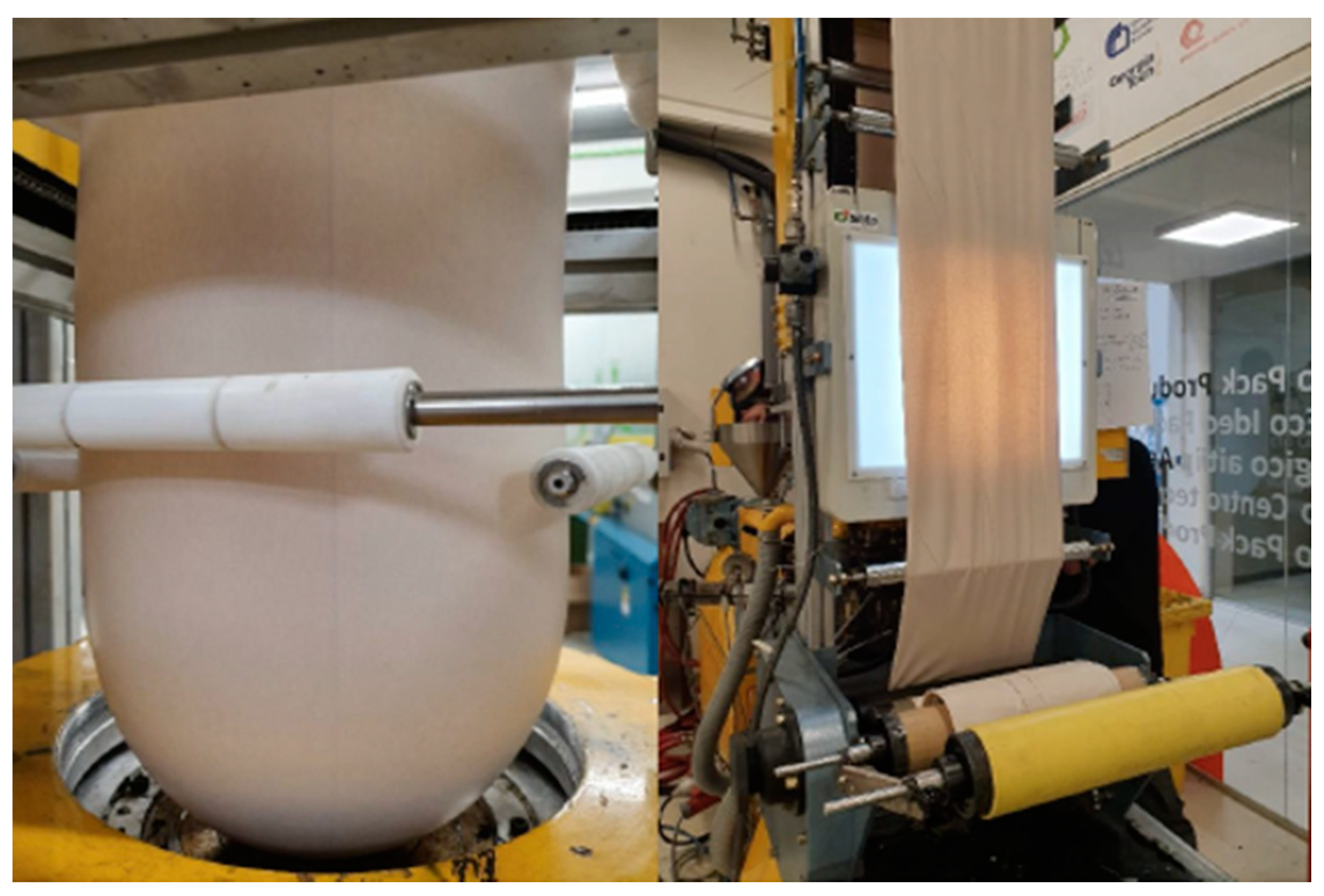
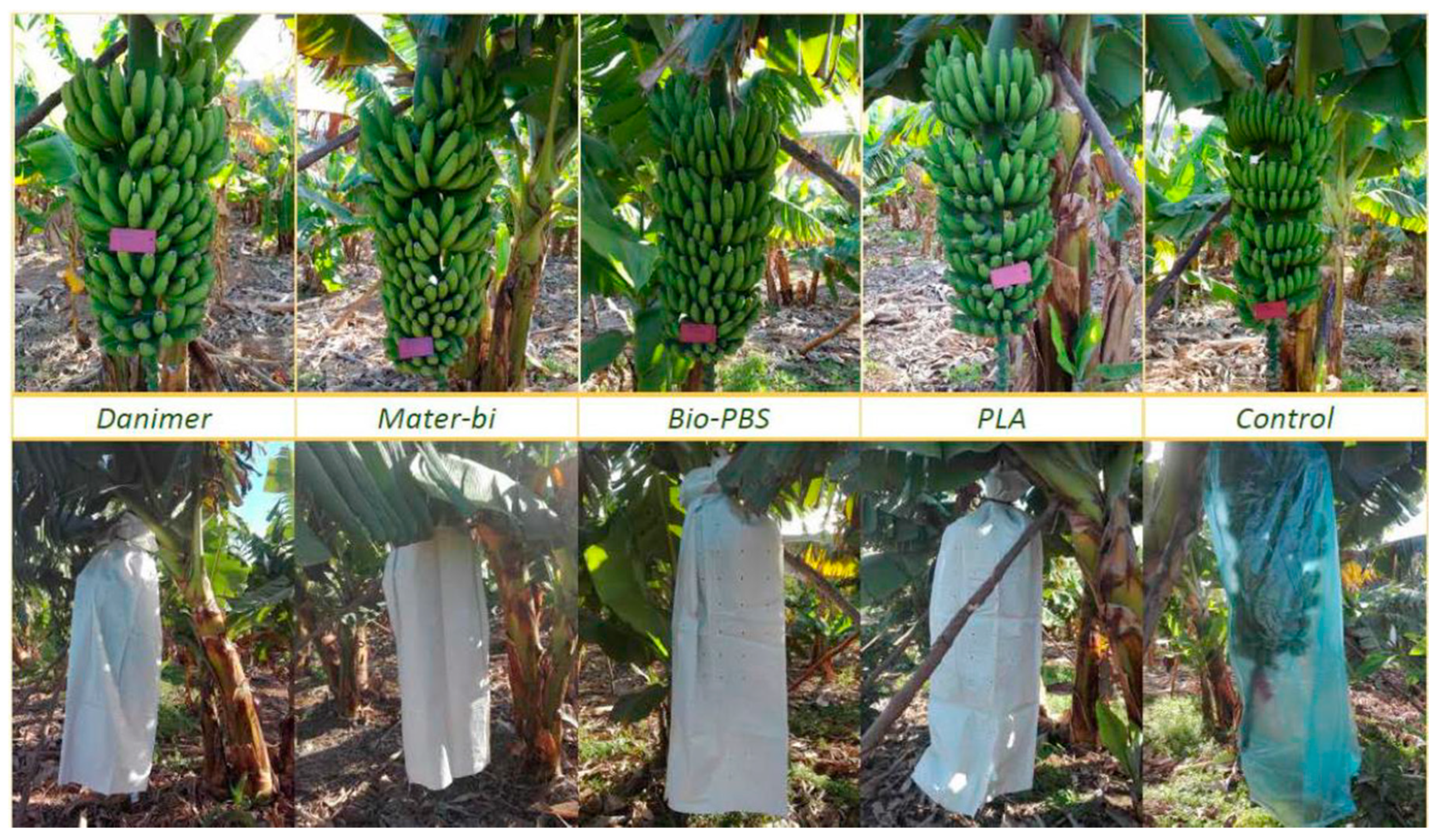
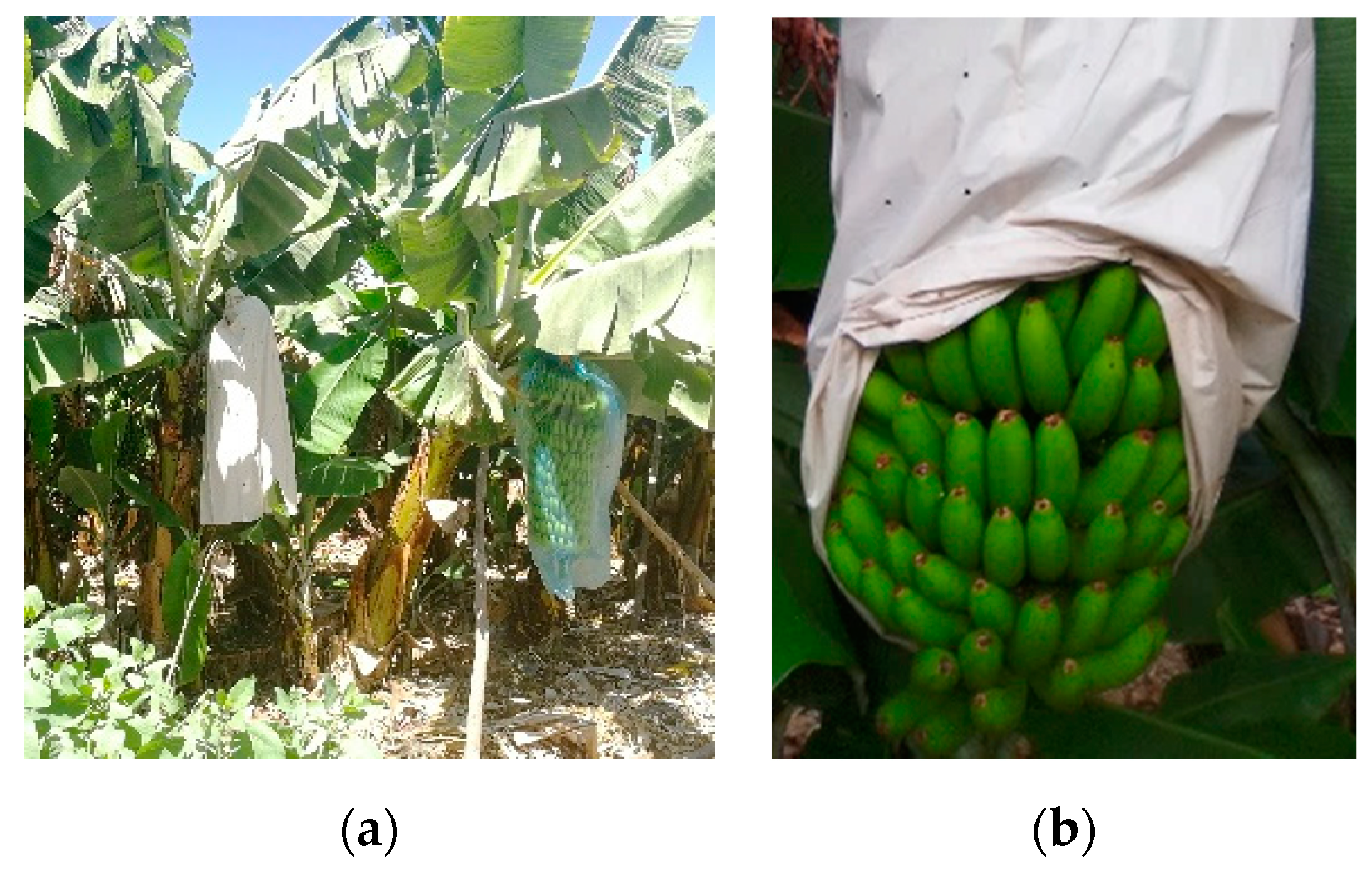

| Type of Bioplastic | Primary Feedstock |
|---|---|
| Thermoplastic starch (TPS) | Starch |
| Plastarch material (PSM) | Starch |
| Starch/polycaprolactone (or polyvinyl acetate) mix | Starch/petroleum |
| PLA | Starch sugars |
| Polyhydroxyalkanoates (PHA) | Starch sugars |
| Cellulose acetate | Wood, cotton or hemp cellulose |
| Lignin | Wood (lignin) |
| Bio Polyethylene | Sugarcane-derived bioethanol |
| Bio Polyurethane | Soya beans |
| BioPBS (Polybutylene succinate) | Sugar cane, corn |
| 1st Film Generation | 2nd Film Generation | 3rd Film Generation |
|---|---|---|
| PLA Ingeo Biopolymer 4032 D (Natureworks) | PLA PLSF 101 B (Natureplast) | - |
| PHA blend Danimer 21906 (Danimer) | - | - |
| Starch and PCL Mater-Bi EF04P (Novamont) | Starch and PCL Mater-Bi EF04P (Novamont) | Starch and PCL Mater-Bi EF04P (Novamont) |
| BioPBS FD92PM (Mitsubishi Chemical Performance Polymers) | BioPBS FD92PM | - |
| Compounding | Flow Rate PLA (kg/h) | Flow Rate BF (kg/h) | Extruder Temperature Range (°C) | Extruder Pressure (bar) | Pelletiser Speed (rpm) |
|---|---|---|---|---|---|
| PLA + 3 mm BF (10%) | 4.5 | 0.5 | 175–180 | 29 | 20 |
| PLA + 5 mm BF (5%) | 5.1 | 0.3 | 175–180 | 4 | 20 |
| Percentage of Different Types of Fibers in the Compounding | |||||
|---|---|---|---|---|---|
| Polymer Matrix | Untreated Banana Fiber (3 mm) | Untreated Banana Fiber (5 mm) | Untreated and Combed Banana fiber (2 mm) | 1st Gen Treated Banana Fiber (2 mm) | 2nd Gen Treated Banana Fiber (Micronised) |
| PLA Ingeo 4032D | 0, 1, 2.5, 5, 10% | 0, 1, 2.5, 5% | 0, 2.5, 5, 7.5, 10% | 0, 2.5, 5, 7.5, 10% | - |
| Danimer 21906 | - | - | - | 0, 1, 2.5, 5% | - |
| Mater-Bi EF04P | - | - | - | 0, 2.5, 5, 10% | 0, 2.5, 5, 7.5, 10% |
| BioPBS FD92PM | - | - | - | 0, 2.5, 5% | 0, 2.5, 5, 7.5, 10% |
| PLA PLSF101 B | - | - | - | - | 0, 2.5, 5, 7.5, 10% |
| 1st Film Generation | 2nd Film Generation | 3rd Film Generation |
|---|---|---|
| PLA + 7% GP 1 + 3% TiO2 + 5% BF | PLA PLSF + 2.5% TiO2 + 5% BF | - |
| Danimer + 3% TiO2 + 5% BF | - | - |
| Mater-Bi + 3% TiO2 + 5% BF | Mater-Bi + 2.5% TiO2 + 5% BF | Mater-Bi + 2.5% TiO2 + 5% BF |
| BioPBS + 3% TiO2 + 5% BF | BioPBS + 2.5% TiO2 + 5% BF | - |
| Particle Size | PLA Compound | Mater-Bi Compound | BioPBS Compound |
|---|---|---|---|
| >500 | 0.00% | 0.00% | 0.00% |
| 425–500 | 36.08% | 10.72% | 19.81% |
| 300–425 | 34.23% | 24.12% | 22.07% |
| 150–300 | 24.88% | 43.21% | 40.99% |
| <4.81 | 4.81% | 21.95% | 18.03% |
| Parameters | Carbon (% D.M.) 1 | Nitrogen (% D.M.) | Humidity (%) | Volatile Solids 550 °C (% D.M.) | pH | C/N Ratio |
|---|---|---|---|---|---|---|
| Inoculum | 1.8 | 0.127 | 25.0 | 7.0 | 7.93 | 14.2 |
| Test material | 21.5 | 190–195 | 1.05 | 99.46 | - | - |
| Compounding | Virgin PLA | PLA + 5% 3 mm BF | PLA + 2.5% 5 mm BF | 1 PLA + 2.5% BF + 5% Plasticizer |
|---|---|---|---|---|
| Extruder screw speed (rpm) | 68 | 68 | 55 | 59 |
| Extruder temperature range (°C) | 190–195 | 190–195 | 195–195 | 190–195 |
| Die temperature range (°C) | 165–185 | 100–185 | 160–180 | 160–185 |
| Melt pressure (bar) | 295 | 295 | 386 | 295 |
| Cooling air speed (rpm) | 351 | 164 | 350 | 351 |
| Vertical nip roll speed (m/min) | 2.0 | 2.2 | 2.4 | 2.0 |
| Windup speed (m/min) | 3.0 | 4.4 | 3.3 | 3.0 |
| Bubble height (m) | 2.0 | 1.9 | 1.8 | 1.7 |
| Compounding 1 | Total Flow Rate (kg/h) | Screw Speed (rpm) | Temperature Range (°C) | Extruder Pressure (bar) | Pelletiser Speed (rpm) |
|---|---|---|---|---|---|
| PLA | 12 | 200 | 170–180 | 4 | 20 |
| Danimer | 11 | 150 | 150–160 | 4 | 20 |
| Mater-Bi | 7 | 100 | 145–155 | 2 | 20 |
| BioPBS | 12 | 100 | 150–160 | 4 | 20 |
| Compounding | Polymer Flow Rate (kg/h) | BF Flow Rate (kg/h) | Screw Speed (rpm) | Extruder Temperature Range (°C) | Extruder Pressure (bar) | Pelletiser Speed (rpm) |
|---|---|---|---|---|---|---|
| PLA (control) | 15 | - | 110 | 150–167 | 4 | 20 |
| PLA + 10% BF | 12 | 1.3 | 110 | 150–167 | 4 | 20 |
| 1 Mater-Bi (control) | 15 | - | 100 | 145–165 | 2 | 20 |
| 1 Mater-Bi + 10% BF | 12 | 1.3 | 110 | 145–165 | 2 | 20 |
| BioPBS (control) | 12 | - | 100 | 140–155 | 4 | 20 |
| BioPBS + 10% BF | 12 | 1.3 | 100 | 140–150 | 4 | 20 |
| Sample | Tensile Elastic Modulus (MPa) | Comparison to 180 MPa (%) | Comparison to 520 MPa (%) |
|---|---|---|---|
| PLA + 5% 2 mm BF | 3487.5 ± 78.7 | 1937.5 | 670.7 |
| Danimer + 5% 2 mm BF | 535.5 ± 22.1 | 297.5 | 103.0 |
| Mater-Bi + 5% 2 mm BF | 235.9 ± 10.3 | 131.1 | 45.4 |
| BioPBS + 5% 2 mm BF | 814.9 ± 37.4 | 452.7 | 156.7 |
| Sample | Tensile Elastic Modulus (MPa) | Tensile Elastic Modulus (Control Sample) (MPa) | Value Compared to Control (%) |
|---|---|---|---|
| PLA + 5% 2 mm BF | 3487.5 ± 78.7 | 3478.2 ± 154.9 | 100.3 |
| Danimer + 5% 2 mm BF | 535.5 ± 22.1 | 490.1 ± 10.5 | 109.3 |
| Mater-Bi + 5% 2 mm BF | 235.9 ± 10.3 | 181.3 ± 29.2 | 130.1 |
| BioPBS + 5% 2 mm BF | 814.9 ± 37.4 | 396.1 ± 38.8 | 205.7 |
| Sample | Tensile Elastic Modulus (MPa) | Tensile Elastic Modulus (Control Sample) (MPa) | Value Compared to Control (%) |
|---|---|---|---|
| PLA + 5% 2 mm BF | 1556.4 ± 6.4 | 940.0 ± 51.6 | 165.6 |
| Mater-Bi + 5% 2 mm BF | 299.1 ± 23.1 | 181.3 ± 29.2 | 165.0 |
| BioPBS + 5% 2 mm BF | 468.6 ± 23.9 | 396.1 ± 38.8 | 118.3 |
| Sample (2nd Generation) | Tensile Elastic Modulus (MPa) | Value Compared to 1st Gen (%) |
|---|---|---|
| PLA + 5% 2 mm BF | 1556.4 ± 6.4 | 44.6 * |
| Mater-Bi + 5% 2 mm BF | 299.1 ± 23.1 | 126.8 |
| BioPBS + 5% 2 mm BF | 468.6 ± 23.9 | 57.5 |
| Compounding | PLA | Danimer | Mater-Bi | BioPBS |
|---|---|---|---|---|
| Extruder screw speed (rpm) | 75 | 45 | 71 | 62 |
| Extruder temperature range (°C) | 185–195 | 145–160 | 145–160 | 145–150 |
| Die temperature range (°C) | 171–185 | 145–145 | 140–161 | 135–150 |
| Melt pressure (bar) | 312 | 333 | 425 | 274 |
| Cooling air speed (rpm) | 300 | 1500 | 2500 | 1780 |
| Vertical nip roll speed (m/min) | 2.0 | 1.5 | 1.2 | 0.9 |
| Windup speed (m/min) | 3.9 | 2.5 | 2.6 | 1.9 |
| Bubble height (m) | 1.8 | 1.7 | 1.7 | 1.7 |
| Compounding | PLA | Mater-Bi 1 | BioPBS |
|---|---|---|---|
| Extruder screw speed (rpm) | 35 | 37 | 57 |
| Extruder temperature range (°C) | 152–165 | 138–148 | 119–129 |
| Die temperature range (°C) | 158–168 | 145–155 | 116–127 |
| Melt pressure (bar) | 99 | 185 | 203 |
| Cooling airspeed (rpm) | 1577 | 1503 | 1847 |
| Vertical nip roll speed (m/min) | 1.1 | 0.8 | 0.9 |
| Windup speed (m/min) | 2.1 | 1.5 | 1.8 |
| Bubble height (m) | 1.4 | 1.5 | 1.5 |
| mg/kg (D.M.) | D.L. 1 | Mater-Bi +5%BF+2.5% TiO2 | Limit (EN 13432) |
|---|---|---|---|
| Arsenic | 2.5 | <D.L. | 5 |
| Cadmium | 0.19 | <D.L. | 0.5 |
| Chromium | 0.5 | 0.75 | 50 |
| Copper | 1 | 1.52 | 70 |
| Lead | 2 | <D.L. | 50 |
| Mercury | 0.3 | <D.L. | 0.5 |
| Molybdenum | 0.5 | <D.L. | 1 |
| Nickel | 1 | <D.L. | 25 |
| Selenium | 0.5 | <D.L. | 0.75 |
| Zinc | 5 | 5.53 | 150 |
| Fluorine | 0.05 | < D.L. | 100 |
| Material | Biodegradability (%) | Time (d) | Total CO2 Production (mg) | Final pH | Average Biodegradability (%) |
|---|---|---|---|---|---|
| Blank 1 | - | - | 1001.0 | 7.91 | - |
| Blank 2 | - | - | 878.5 | 7.88 | - |
| Blank 3 | - | - | 929.8 | 7.98 | - |
| R.M. 1 1 | 100.5 | 180 | - | 7.89 | 99.3 ± 13.8 |
| R.M. 2 | 98.6 | 180 | - | 7.82 | |
| R.M. 3 | 98.7 | 180 | - | 7.88 | |
| Test material 1 | 99.8 | 180 | - | 7.99 | 99.3 ± 0.5 |
| Test material 2 | 99.3 | 180 | - | 8.01 | |
| Test material 3 | 98.8 | 180 | - | 7.91 |
| Parameter | Soil (Control Sample) | Mater-Bi +5%BF +2.5% TiO2 | Mixed Fertiliser |
|---|---|---|---|
| Plastics, glass, metals (>2 mm) (%) | absent | 0.12 | <0.5% D.M. |
| Inert material (>5 mm) (%) | absent | absent | <5% D.M. |
| Moisture (%) | 55.0 | 52.2 | 50–55% |
| pH | 7.9 | 8.0 | 6–8.5 |
| Organic carbon (%) | 22.9 | 20.0 | ≥20% D.M. |
| Carbon/Nitrogen ratio (%) | 14.5 | 11.8 | <25% |
| mg/kg (D.M.) | Soil (Control Sample) | Mater-Bi +5%BF+2.5% TiO2 | Limit (EU 2018/848) |
|---|---|---|---|
| Cadmium 1 | 0.26 | 0.23 | 0.7 |
| Chromium VI 1 | 0 | 0 | n.d. 3 |
| Copper 1 | 31.2 | 27.4 | 70 |
| Mercury 1 | 0.11 | < 0.1 | 0.4 |
| Lead 1 | 18.7 | 17.8 | 45 |
| Zinc 1 | 93 | 77 | 200 |
| Total chromium 2 | 262 | 178 | 70 |
| Nickel 2 | 241 | 165 | 25 |
| Plant | Test Soil Concentration (%) | Germination (%) | Fresh Weight (g) | Germination Rate (%) | Fresh Weight Rate (%) | ||
|---|---|---|---|---|---|---|---|
| Average | SD 1 | Average | SD | Endpoint | Average | ||
| Barley | 25 | 97.00 | 2.08 | 26.75 | 0.55 | 98.32 | 98.29 |
| Barley | 50 | 98.33 | 1.73 | 26.34 | 0.52 | 100.68 | 100.30 |
| Cress | 25 | 77.23 | 2.00 | 5.60 | 0.18 | 97.59 | 98.96 |
| Cress | 50 | 79.67 | 3.06 | 5.11 | 0.20 | 100.00 | 96.40 |
| Plant | Control Soil Concentration (%) | Germination (%) (>70%) | Surviving Rate (%) (>90%) | Phytotoxic Effects (None) |
|---|---|---|---|---|
| Barley | 25 | 98.66 | 100.00 | None |
| Barley | 50 | 97.67 | 100.00 | None |
| Cress | 25 | 79.14 | 97.19 | None |
| Cress | 50 | 79.67 | 95.92 | None |
Publisher’s Note: MDPI stays neutral with regard to jurisdictional claims in published maps and institutional affiliations. |
© 2021 by the authors. Licensee MDPI, Basel, Switzerland. This article is an open access article distributed under the terms and conditions of the Creative Commons Attribution (CC BY) license (http://creativecommons.org/licenses/by/4.0/).
Share and Cite
Bordón, P.; Paz, R.; Peñalva, C.; Vega, G.; Monzón, M.; García, L. Biodegradable Polymer Compounds Reinforced with Banana Fiber for the Production of Protective Bags for Banana Fruits in the Context of Circular Economy. Agronomy 2021, 11, 242. https://doi.org/10.3390/agronomy11020242
Bordón P, Paz R, Peñalva C, Vega G, Monzón M, García L. Biodegradable Polymer Compounds Reinforced with Banana Fiber for the Production of Protective Bags for Banana Fruits in the Context of Circular Economy. Agronomy. 2021; 11(2):242. https://doi.org/10.3390/agronomy11020242
Chicago/Turabian StyleBordón, Pablo, Rubén Paz, Carolina Peñalva, Gisela Vega, Mario Monzón, and Lidia García. 2021. "Biodegradable Polymer Compounds Reinforced with Banana Fiber for the Production of Protective Bags for Banana Fruits in the Context of Circular Economy" Agronomy 11, no. 2: 242. https://doi.org/10.3390/agronomy11020242
APA StyleBordón, P., Paz, R., Peñalva, C., Vega, G., Monzón, M., & García, L. (2021). Biodegradable Polymer Compounds Reinforced with Banana Fiber for the Production of Protective Bags for Banana Fruits in the Context of Circular Economy. Agronomy, 11(2), 242. https://doi.org/10.3390/agronomy11020242






